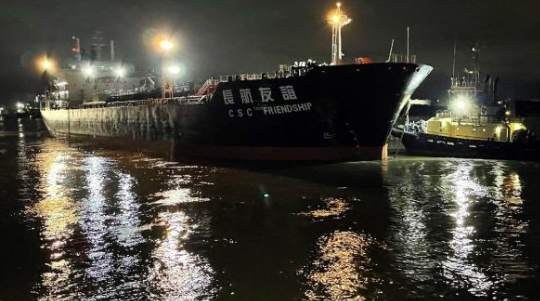Lessons Learned: Oil Tanker, Breakaway, Grounding

Breakaway and grounding of oil tanker CSC Friendship, Port of Brisbane.
The breakaway and grounding of an oil tanker in the Brisbane River during a significant weather event in February 2022 illustrates the importance of clearly defined emergency and risk management arrangements, according to an ATSB (Australian Transport Safety Bureau) investigation report.
On February 27, 2022, during a period of heavy, sustained rainfall and flooding in southeast Queensland, the 185 m Hong Kong-flagged oil tanker CSC Friendship was berthed at the Ampol products wharf in the Port of Brisbane.
Currents in the Brisbane River increased until they exceeded the design mooring limits of both the oil tanker ship and the berth, the ATSB investigation found.
“While weather conditions exceeded those initially forecast, the associated increased safety risk to shipping and the port was foreseeable,” ATSB marine investigation manager Captain Vik Chaudhri said.
“Numerous warnings from the Bureau of Meteorology provided sufficient information to identify and assess the increased likelihood of a breakaway, and the current in the river had exceeded the operational limits of the berth and the ship’s mooring arrangements more than 14 hours prior to the breakaway – yet the ship remained at the berth.”
The ship, loaded with about 32,000 tons of petroleum products, broke its mooring lines just prior to 11 pm.
Despite the deployment of the ship’s outboard anchor and the swift attendance of two tugs, the ship was swept across the channel, grounding 400 m downstream.
A port pilot boarded the vessel and, about six hours after the grounding, the ship was refloated.
However, during the recovery efforts, an attempt was made to retrieve the anchor, leading the ship to veer across the channel and ground again, close to Clara Rock, a charted hazard.
The anchor was then slipped and the ship was safely conducted downriver into Moreton Bay, where it anchored.
Weather events can pose dynamic hazards to port infrastructure and ships, and their safe management requires clearly defined emergency and risk management arrangements,” Captain Chaudhri explained.
“These include accurately assessing all available information and erring on the side of safety where doubt exists – in particular considering the inherent uncertainty of weather forecasts.”
The ATSB’s investigation found Maritime Safety Queensland (MSQ), whose responsibilities include the management of an emergency in the Port of Brisbane, did not have structured or formalized risk or emergency management processes or procedures.
“Consequently, MSQ was unable to adequately assess and respond to the risk posed by the river conditions and current.”
MSQ has made significant changes to operations and systems in response to the incident and flood event, including policy and procedural updates and capital improvements.
It has also engaged with multiple investigations and analyses of the incident, engaged with multiple port stakeholders and facility owners, and established a distinct management role to lead a dedicated Maritime Emergency Management team.
However, while significant, the ATSB has assessed the safety action taken by MSQ has not fully addressed the identified safety issue concerning its risk management processes and procedures to manage any type of emergency.
“Subsequently, the ATSB has issued a safety recommendation to MSQ to further improve these processes and procedures,” Captain Chaudhri explained.
The final ATSB report also notes safety actions taken by the pilotage provider, Poseidon Sea Pilots, who the investigation identified did not have procedures to manage predictable risks associated with increased river flow or pilotage operations outside normal conditions.
In response, Poseidon Sea Pilots has taken various safety actions, including collaborating with MSQ on emergency evacuation procedures to respond to increased river flow.
Finally, the ATSB’s final report notes that Ampol had not considered the risk to the ship or the wharf due to increased river flow.
The wharf operator has subsequently conducted an incident investigation and analysis of mooring arrangements and limitations, and developed a document to specify wharf operational limits, and response actions for varying wind and river speeds.
“The extent of actions by all three of these key parties is encouraging,” Captain Chaudhri said.
“With these processes established, coordinated and timely decisions can be made when risks increase during future events like this one. Defined trigger points, priority lists, and escalation and contingency plans and procedures will help drive effective emergency responses.”
Read the final ATSB report: Breakaway and grounding of CSC Friendship, Port of Brisbane, Queensland, on 27 February 2022.



